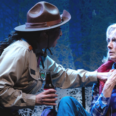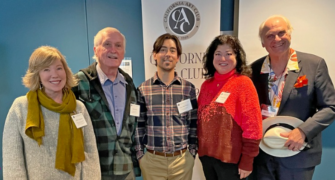
From left, Blair Hansen, founding member of the Hahamongna Accountability Project, Tim Brick, Executive Director of Stewards of the Arroyo Seco, Tim Martinez, Program Administrator of the Arroyos & Foothills Conservancy, Wendy Katagi, Senior Manager, Watershed and Ecosystem Restoration Services for Stillwater Science, and Peter Adams, President Emeritus of the California Art Club at the Feb. 1, 2024 panel at the Pasadena Museum of History. [Eddie Rivera/Pasadena Now]
The possibility that the Los Angeles County Board of Supervisors will revive the Arroyo Seco Ecosystem Restoration project took center stage at a hopeful panel discussion on the ‘Future of the Arroyo Seco’ held at the Pasadena Museum of History on Thursday evening.
Tim Martinez of the Arroyo & Foothills Conservancy, Wendy Katagi of Stillwater Sciences, Peter Adams of the California Art Club, Blair Hansen of the Hahamongna Accountability Project, and Tim Brick of Stewards of the Arroyo Seco presented an upbeat assessment of the future of Hahamongna Watershed Park, what President Theodore Roosevelt once said could be “one of the greatest parks in the world.”
Brick said enthusiastically he is convinced that Los Angeles County will work again with cities and organizations along the Arroyo Seco and Los Angeles River to reinitiate the Arroyo Seco Ecosystem Restoration project. The project was originally begun in 2001 but stumbled in 2017 when the United States Army Corps of Engineers announced that it needed additional funding to complete the plan.
The project is an ongoing collaborative effort involving the County of Los Angeles Department of Public Works, the U.S. Army Corps of Engineers, and various environmental organizations, aiming to address environmental and water resource issues in the Arroyo Seco Watershed.
Plans were recently revitalized after the project fell in line when a 2021 federal infrastructure bill appropriated $28 million towards habitat restoration in the Arroyo Seco,
Brick said he believes that in May the Los Angeles County Board of Supervisors will approve a reconfiguration of the project and will “go back to the cities and to the partners who have participated in the project in the past. And they’re going to say, ‘What do you want to do?’ So we have some ideas about what we’d like them to do, and we hope that they’ll follow up on it.”
Brick continued, “It’s all based on the restoration of streams and habitat, and improving the Arroyo Seco as much as they can, with a natural emphasis,” said Brick. “They’re looking at everything from the San Gabriel Mountains to Downtown [Los Angeles].”
Asked if the plan would include the eventual removal of the concrete walls of the Arroyo Seco Channel, Brick replied, “We sure hope so.”
Martinez, who is Program Administrator of the Arroyo & Foothills Conservancy, a nonprofit land trust in Pasadena, added, “We have this vision for removing impediments — not only impediments to water and to fish, but how can we remove physical barriers and physical impediments, and chain link fences, things like that to help the wildlife movement as well.”
“But really,” he continued, “what I think tonight is all about is the future of the Arroyo. It’s about letting it all flow. Letting the water flow again, having a natural river again, restoring the habitat, removing the physical barriers, and enhancing it for wildlife, for fish, and ultimately for all of us, as well.”
Meanwhile, Brick said, “That is a model for a lot of other areas in our area. So one of the things to keep in mind is very important. Most people don’t think of it much, but the flood channel is inadequate for future floods. They’re likely to come, and the county knows that.”
Expounding on Martinez’s theme, Brick and his organization are proposing a series of what he termed “Arroyo River parks”
“And that’s because there are 30 parks and public spaces that line the Arroyo Seco from the mountains all the way down to the LA River,” he explained, “that are ideal for reconfiguring so that they become river parks.”
Martinez outlined and highlighted the special layout and geography of the area, describing the Rosemont Preserve, eight acres at the northern tip, at the foot of the San Gabriel Mountains, along with Millard Canyon, which is part of the 13-acre Arroyo Cycle watershed near Canyon Crest Road in Altadena.
He also pointed to Rubio Canyon, 41 acres in Altadena east of Blake Avenue at the foot of the San Gabriel Mountains, as well as Cottonwood Canyon on the edge of the Arroyo Seco, just above the Brookside Golf Course and the Rose Bowl.
Katagi, who is Senior Manager of Watershed and Ecosystem Restoration Services for Stillwater Sciences, also noted the improved ecosystems that have dramatically improved fish habitats and increased the number of local steelhead trout.
Hahamongna Accountability Project founding member Hansen pointed out the work and successes achieved by the Project in holding Los Angeles County accountable to its assurances during the recent
“Big Dig” Devil’s Gate Dam dredging project.
Three of the panelists spoke with Pasadena Now in the days leading up to the event.
Brick said some proposals concerning the conservation and restoration of the Arroyo Seco have raised significant concerns. He said a proposal for a miniature golf course linked to the Rose Bowl Operating Company threatens to compromise the Arroyo’s natural character, potentially causing lighting and traffic issues.
Similarly, a project near San Rafael Creek aims to address pollution but fails to align with the Arroyo’s restoration goals, he said. In South Pasadena, another project diverts contaminated stream water into the ocean, lacking consideration for the Arroyo’s natural integrity. Brick said these initiatives represent a trend of single-purpose approaches that prioritize economic gain over watershed restoration.
“Our goal is very much restoring the watershed and taking a big watershed approach,” he said. “So I would say that unfortunately that’s not motivating these other projects.”
Peter Adams shared his perspective as an artist deeply connected to Arroyo Seco’s aesthetic allure and spoke of the peaceful tranquility and environmental respect depicted in his artwork.
“There are many scenes in the Arroyo Seco that have a peaceful tranquility that you often find in Asian art,” Adams said. “And that falls in line with some of my aesthetic concepts and my painting style; the wonderful rock formations and the different foliage and so forth make for wonderful, interesting designs, but also speak of a deep love of the environment. And that’s something that I really cherish in my artwork – a real respect, I guess, for the environment.”
Wendy Katagi, from Stillwater Sciences, highlighted the Arroyo Seco’s significance as one of the most biodiverse regions in Southern California. She discussed environmental threats and innovative restoration methods aimed at preserving habitat connectivity and biodiversity.
“Nested within the Angeles National Forest and San Gabriel Mountains, the Arroyo Seco contains many of our most rare species, particularly in the headwaters where habitat is largely intact for aquatic, riparian, and terrestrial species,” Katagi said. “As such, protecting, restoring, and enhancing habitat connectivity and flows from the headwaters to the oceans is critical to watershed health and conservation efforts.”














 7 comments
7 comments


